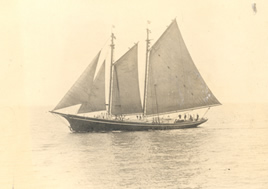
Harry Gabriel Hamlet was the seventh Commandant of the United States Coast Guard, from 1932 to 1936.

USS Bancroft was a United States Navy steel gunboat in commission from 1893 to 1898 and again from 1902 to 1905. She saw service during the Spanish–American War. After her U.S. Navy career, she was in commission in the United States Revenue Cutter Service from 1907 to 1915 as the revenue cutter USRC Itasca, and in the Revenue Cutter Service's successor service, the United States Coast Guard, as the cutter USCGC Itasca from 1915 to 1922. During her Coast Guard career, she saw service during World War I.
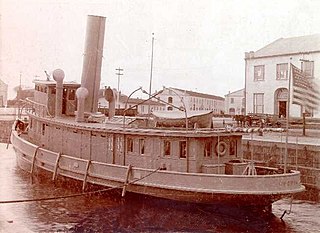
USRC Hudson, known for her service during the Battle of Cárdenas, was the United States Revenue Cutter Service's first vessel to have a steel hull and triple-expansion steam engine.
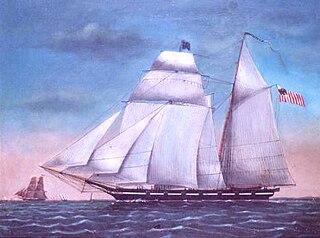
The United States Revenue Cutter Crawford was the first of the 13 cutters of the Morris-Taney Class to be launched. These cutters were the backbone of the U.S. Revenue Cutter Service for more than a decade. Samuel Humphreys designed these cutters for roles as diverse as fighting pirates, privateers, combating smugglers and operating with naval forces. He designed the vessels on a naval schooner concept. They had Baltimore Clipper lines. The vessels built by Webb and Allen, designed by Isaac Webb, resembled Humphreys' but had one less port
USRC Walter Forward was a schooner constructed for service with the United States Revenue-Marine. She was more commonly known as USRC Forward. Forward served with the United States Army and United States Navy in Mexican waters during the Mexican–American War and was commended for her actions during the Tabasco River landings by Commodore Matthew C. Perry, U.S. Navy. After the war, she was transferred to the United States Coast Survey for a short time as USCS Walter Forward before being returned to the Revenue-Marine for service during the 1850s and the American Civil War.

USRC Eagle was one of the first ten cutters operated by the United States Revenue-Marine, which later became the United States Revenue Cutter Service and later still became part of the United States Coast Guard.

Worth G. Ross is known as the third Commandant of the Coast Guard, although he was never formally appointed to that position. Joining the United States Revenue Cutter Service in 1877, he graduated from the Revenue Cutter Service School of Instruction's first class in 1879. He held a variety of appointments during the late 19th century before being appointed Captain-Commandant of the service in 1905. In this capacity he commanded a number of cutters on the United States Gulf Coast and was responsible for moving the School of Instruction to Fort Trumbull, Connecticut. He was a relation of Brevet Brigadier General Samuel Ross (1822-1880), who commanded the 20th Connecticut Infantry during the American Civil War.
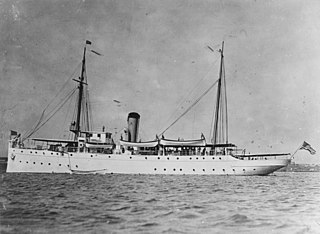
USCGC Tampa (ex-Miami) was a Miami-class cutter that initially served in the U.S. Revenue Cutter Service, followed by service in the U.S. Coast Guard and the U.S. Navy. Tampa was used extensively on the International Ice Patrol and also during the Gasparilla Carnival at Tampa, Florida and other regattas as a patrol vessel. It was sunk with the highest American naval combat casualty loss in World War I.

USRC Manning was a revenue cutter of the United States Revenue Cutter Service that served from 1898 to 1930, and saw service in the U.S. Navy in the Spanish–American War and World War I.

USRC Onondaga was an Algonquin-class cutter built for the U.S. Revenue Cutter Service for service on the Great Lakes. Because of the Spanish–American War, she was cut in half shortly before completion and transported to Ogdensburg, New York for service on the Atlantic coast although the war ended before she could be put into service. After the formation of the United States Coast Guard in 1915 she became USCGC Onondaga. She served as a patrol vessel at various Atlantic coast ports before World War I and unlike most Coast Guard cutters during World War I, she remained under the control of the Commandant of the Coast Guard. After the war she patrolled for a brief time based at New London, Connecticut before being decommissioned in 1923.
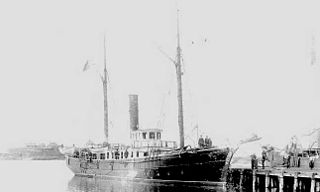
USRC Dexter was a Dexter-class cutter of the United States Revenue Cutter Service in commission from 1874 to 1908. She was the second ship of the Revenue Cutter Service to bear the name. The other Dexter-class cutters, all commissioned in 1874, were Dallas and Rush. Dexter was built by the Atlantic Works Company at Boston, Massachusetts. Captain John A. Henriques accepted her for service on 6 June 1874, and she was commissioned into the Revenue Cutter Service on 18 June 1874. Her role in the rescue of passengers from the sinking SS City of Columbus under winter gale winds brought her nationwide popular acclaim.
USRC Moccasin was a Revenue Cutter purchased from the U.S. Navy in 1865 and immediately assigned to duty at Norfolk, Virginia where future Chief of the Revenue Marine Service, Leonard G. Shepard, future Chief of the Revenue Marine Bureau reported on board as a newly commissioned Third Lieutenant as part of the commissioning crew. In May 1866 her homeport was moved to Wilmington, North Carolina where she served until being moved for repairs at the Philadelphia Navy Yard in 1869. After repairs she was assigned to Newport, Rhode Island from 1869 to 1872 and then transferred to Charleston, South Carolina. In 1881, she was taken to the Slater and Read Shipyard in New York City and was lengthened to 128 feet. On 10 April 1882 she was recommissioned as USRC George Bibb and moved to the Great Lakes. The George Bibb was named after the seventeenth Secretary of the Treasury, George M. Bibb. While winter quarters were at Ogdensburg, New York, she was also stationed at Duluth, Minnesota, Detroit, Michigan and Oswego, New York. After decommissioning in November 1890, she was sold in Buffalo, New York for $2500. She became the merchant vessel Pentagoet which foundered in November 1898.
USRC Forward was a revenue cutter constructed for the U.S. Revenue Cutter Service in 1882 by Pusey & Jones shipyard in Wilmington, Delaware. She was the second Revenue Cutter Service vessel named Forward and was named for Walter Forward, the fifteenth United States Secretary of the Treasury. The iron-hulled vessel originally cost US$72,750 and was powered by a two-cylinder steam engine with a topsail schooner brigantine sail pattern. Although Forward was considered a model ship at the time of its construction, it was severely underpowered and had unreliable machinery. The cost of repairs in the first fifteen years of operation was US$52,000.

USRC Salmon P. Chase was named after Abraham Lincoln's Secretary of the Treasury, Salmon Portland Chase. It was a three-masted bark with a hull length of 106 feet that was designed for use as a training ship for the cadets of the Revenue Cutter Service School of Instruction.

USRC Yamacraw, was a steel-hull flush-deck cutter that served in the United States Revenue Cutter Service from 1909 to 1937 and was the sister ship to the USRC Tahoma.

USRC Pamlico was a revenue cutter of the United States Revenue Cutter Service that served from 1907 to 1946 designed specifically to cruise inland waters and did so while stationed at New Bern, North Carolina her entire career.

USRC George S. Boutwell was a revenue cutter of the United States Revenue Cutter Service that served from 1873 to 1907 designed for cruising the southern coasts. She was named for George S. Boutwell, the 28th United States Secretary of the Treasury.
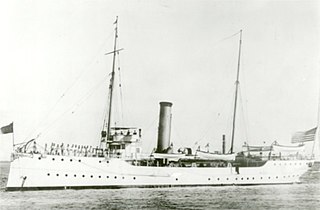
USRC Algonquin was an Algonquin-class cutter built for the U.S. Revenue Cutter Service for service on the Great Lakes. Because of the Spanish–American War, she was cut in half shortly before completion and transported to Ogdensburg, New York for service on the Atlantic coast although the war ended before she could be put into service. She was homeported at San Juan, Puerto Rico from 1905 to 1917. Algonquin served briefly for the U.S. Navy along the Atlantic Coast in the summer of 1898 before being returned to the Treasury Department. After the formation of the United States Coast Guard in 1915 the vessel became USCGC Algonquin. The ship served as a patrol vessel at Norfolk, Virginia at the beginning of World War I before being assigned convoy duty in the Mediterranean. In February 1919 Algonquin was transferred to the West Coast and served in the Pacific Northwest and Alaska until being decommissioned at San Francisco in December 1930.
John A. Henriques was a United States Revenue Cutter Service officer that was noted for helping form the establishment of the Revenue Cutter Service School of Instruction, which later became the United States Coast Guard Academy.
USRC Lincoln was a revenue cutter commissioned by the U.S. Revenue–Marine and named in honor of the 16th United States president, Abraham Lincoln.
